ASUS Maximus Extreme - the Extreme Benchmarker's Choice?
by Rajinder Gill on December 10, 2007 8:00 AM EST- Posted in
- Motherboards
XP Overclocking Benchmarks
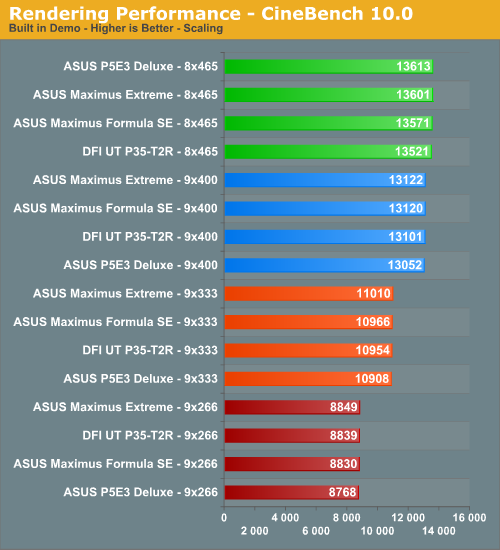
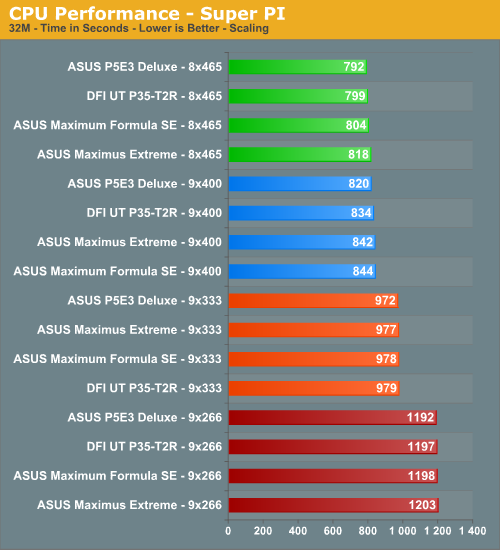
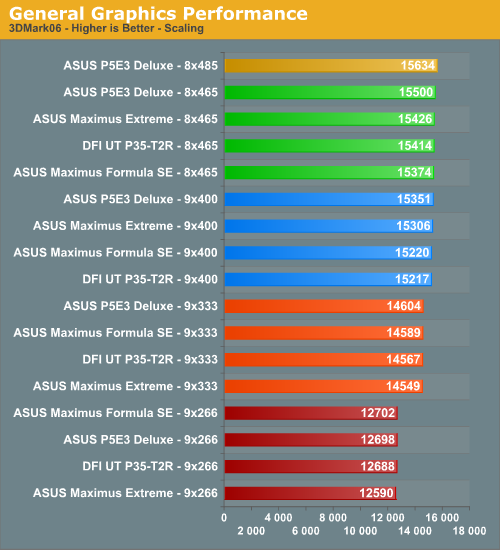

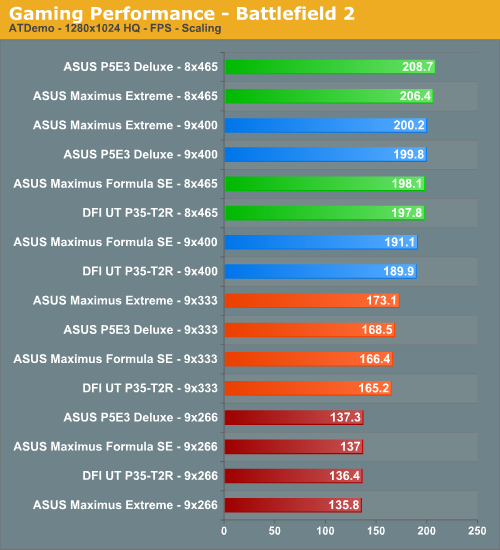
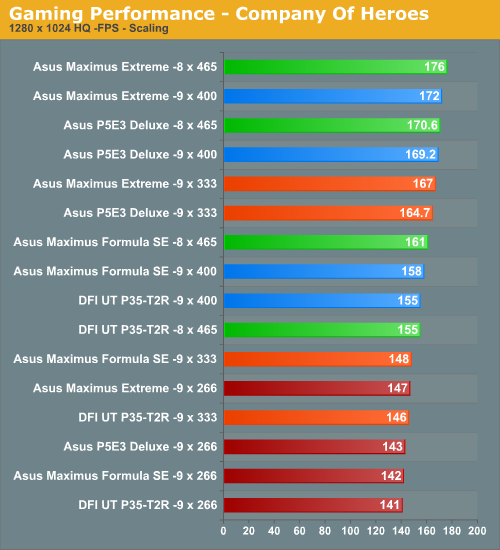
Thoughts on basic overclocking
The Maximus Extreme fares well in all our 3D based tests. Obviously, the performance gains are not huge, as you never get double the performance for double the price. Results between the P5E3 Deluxe and the Maximus Extreme are tight, so choosing either board for a daily system is not going to offer significant advantages at this level of overclocking. Benchmarks such as Super Pi 32M really benefit from very tight secondary RAM timings - often far beyond the capabilities of complete system stability - so take the largely un-tuned results here with a pinch of salt. The board is stable up to around 465 FSB with 65nm quad processors. For those who are interested in Folding@Home, 450 FSB is the real limit.
Although not shown here, we did run some Vista based stability testing with 4GB of memory. Results were very promising: full 4GB stability at DDR3 1700-1800 with 1N command rate also came in around 445-450FSB. Users who buy this board with 24/7 use in mind will generally be avid gamers. For this purpose, the X38 boards are marginally faster than their P35 based counterparts are. Also remember, with X38 boards the option of dual - or in this case triple - graphics cards can provide a level of future proofing. Especially as gaming engines are becoming more complex, dual GPUs will be necessary to play games at high-res with maximum detail settings for the near future.
If the sole reason for choosing this board is the additional DDR3 performance gains (albeit small), then top-end DDR3-1800 modules will be necessary to realize any benefits. At speeds below DDR3-1600 to DDR3-1333, CA 6 to CAS5 performance with DDR3 will show results close to DDR2-1150 at CAS5. If you prefer dual graphics cards without the added expenditure hit of DDR3 memory, there are a couple of DDR2 X38 boards to chose from. The ASUS Maximus Formula fills the role admirably for more advanced overclockers or the Gigabyte GA-X38-DQ6 is a nice alternative.










27 Comments
View All Comments
takumsawsherman - Tuesday, December 11, 2007 - link
This is not really true, as Firewire800 has been out for some time, and eSATA is still not widely available. As for the comment above yours, Firewire800 is used in many media applications, and won't likely be eliminated soon (digital camera backs come to mind). And this doesn't answer my proposition that for $350, Firewire800 rather than Firewire400 should have been included. Why bother with the slower interface when you are paying for a "premium" product?I am sure that some manufacturers will be happy to see Firewire800 die. Heck, I'm sure they'd be happy if there was never a Firewire400, and we all used USB 1.1. After all, it's cheaper by 2 or 3 bucks, and that's what matters to them. Meanwhile, despite claims of durability, eSATA is still a weak connector, which is why you will still see photographers taking shots tethered to a Firewire800 bus when they're on location for years to come, rather than a eSATA connection.
For $350, they can add Firewire800. Heck, the price is just shy of 1/3 of a fully assembled iMac that includes Firewire800. Just for the motherboard.
retrospooty - Tuesday, December 11, 2007 - link
"Firewire800 has been out for some time, and eSATA is still not widely available"Yes it is widely available. It has been on nearly every high end and many mid range motherboards for over a year. Also, every major external drive maker has eSATA models... Not many fw800 at all.
I am not trying to flame you or anything, but firewire 800 isnt going to happen, not like fw400 did. At the time fw400 was the best interface. Now we have eSATA for hard drives and USB 3.0 coming in a year or two. FW800 is dead Jim.... its dead.
takumsawsherman - Wednesday, December 12, 2007 - link
I still don't see any media-based hardware that has eSATA. Much more firewire on that front. In fact, besides Hard Drive enclosures, I have not seen anything at all with eSATA.And again, if it is dead, why bother putting FW400 in? I mean, might as well save the user $5 from their $350 and eliminate it. Or, give them FW800 like you should have.
strikeback03 - Wednesday, December 12, 2007 - link
I'd imagine it's there just so they can have a checkmark next to "Firewire" in the comparison sheets. The only Firewire device I have ever used is our microscope camera, which I believe was designed prior to USB 2.0.I wouldn't say the eSata connector is weak, but the lack of flexibility in the cables is an annoyance.
takumsawsherman - Wednesday, December 12, 2007 - link
Ok, well I still haven't used a eSATA device. I have used an external SATA enclosure, as MOBO makers decided to start out with external SATA connectors and I've used a FW800 device that also has an eSATA port (Newer Technology ministack v3), but of course, the Mac it is attached to does not have eSATA. I'm happy they included it, though.The point still remains that at $350 they give you the old generation firewire instead of the new.
retrospooty - Wednesday, December 12, 2007 - link
Are there any motherboards with fw800 built in (other than maybe MAC)? just curious.takumsawsherman - Tuesday, December 11, 2007 - link
OK, my post ended up as a reply to the wrong post. Sorry.retrospooty - Monday, December 10, 2007 - link
Yes, USB kb/mice work in dos mode via a bios setting. just enable it.Etern205 - Monday, December 10, 2007 - link
I'm taking about wireless. Are you talking about wireless or wired?If it's wired then yes you'll have enable usb support for DOS if you want to use it.
strikeback03 - Tuesday, December 11, 2007 - link
My Bluetooth keyboard works now, however when I first installed Ubuntu I had the BIOS setting disabled, and the keyboard never worked in GRUB thereafter. Was not until I reinstalled with the BIOS setting enabled that I got the keyboard working in GRUB.Works in the BIOS regardless of the setting.